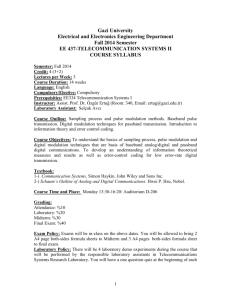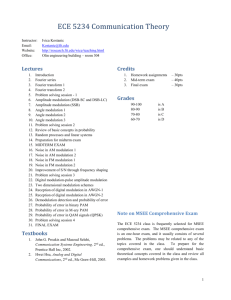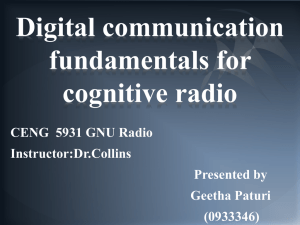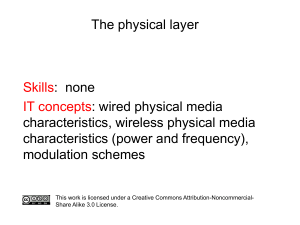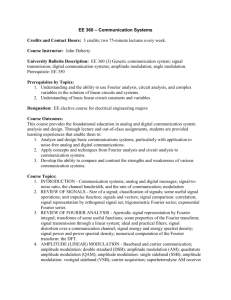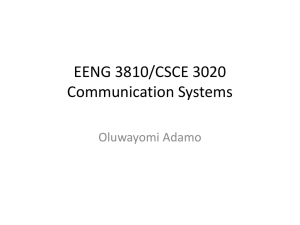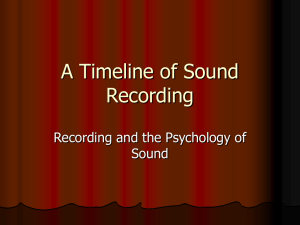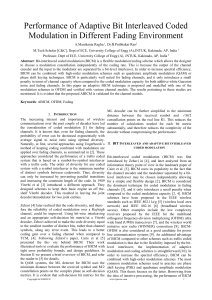EE 571 Digital Communications I
advertisement
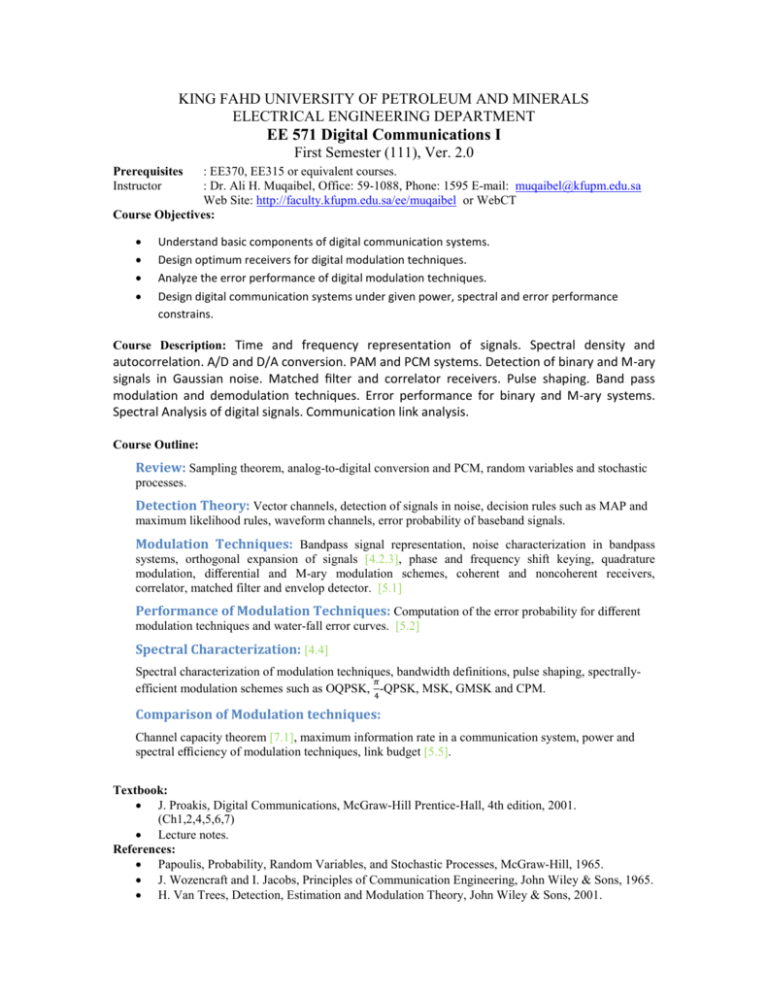
KING FAHD UNIVERSITY OF PETROLEUM AND MINERALS ELECTRICAL ENGINEERING DEPARTMENT EE 571 Digital Communications I First Semester (111), Ver. 2.0 Prerequisites Instructor : EE370, EE315 or equivalent courses. : Dr. Ali H. Muqaibel, Office: 59-1088, Phone: 1595 E-mail: muqaibel@kfupm.edu.sa Web Site: http://faculty.kfupm.edu.sa/ee/muqaibel or WebCT Course Objectives: Understand basic components of digital communication systems. Design optimum receivers for digital modulation techniques. Analyze the error performance of digital modulation techniques. Design digital communication systems under given power, spectral and error performance constrains. Course Description: Time and frequency representation of signals. Spectral density and autocorrelation. A/D and D/A conversion. PAM and PCM systems. Detection of binary and M-ary signals in Gaussian noise. Matched filter and correlator receivers. Pulse shaping. Band pass modulation and demodulation techniques. Error performance for binary and M-ary systems. Spectral Analysis of digital signals. Communication link analysis. Course Outline: Review: Sampling theorem, analog-to-digital conversion and PCM, random variables and stochastic processes. Detection Theory: Vector channels, detection of signals in noise, decision rules such as MAP and maximum likelihood rules, waveform channels, error probability of baseband signals. Modulation Techniques: Bandpass signal representation, noise characterization in bandpass systems, orthogonal expansion of signals [4.2.3], phase and frequency shift keying, quadrature modulation, differential and M-ary modulation schemes, coherent and noncoherent receivers, correlator, matched filter and envelop detector. [5.1] Performance of Modulation Techniques: Computation of the error probability for different modulation techniques and water-fall error curves. [5.2] Spectral Characterization: [4.4] Spectral characterization of modulation techniques, bandwidth definitions, pulse shaping, spectrally𝜋 efficient modulation schemes such as OQPSK, -QPSK, MSK, GMSK and CPM. 4 Comparison of Modulation techniques: Channel capacity theorem [7.1], maximum information rate in a communication system, power and spectral efficiency of modulation techniques, link budget [5.5]. Textbook: J. Proakis, Digital Communications, McGraw-Hill Prentice-Hall, 4th edition, 2001. (Ch1,2,4,5,6,7) Lecture notes. References: Papoulis, Probability, Random Variables, and Stochastic Processes, McGraw-Hill, 1965. J. Wozencraft and I. Jacobs, Principles of Communication Engineering, John Wiley & Sons, 1965. H. Van Trees, Detection, Estimation and Modulation Theory, John Wiley & Sons, 2001. Sklar, Digital Communications Fundamental and Applications, Prentice-Hall, 1988. S. Wilson, Digital Modulation and Coding, Prentice-Hall, 1995. Homework Assignments: Homework will be issued about once every two weeks. Collaborative work is encouraged between students. However, solutions are to be worked out and submitted individually. Grading Policy: Homework problems Exam I Exam II Quizzes Final Exam Term Paper 12% 20% 20% 8% 30% 10% Saturday of Week 7 (Oct. 22, 2011, Class time) Saturday of Week 12 (Dec. 3, 2011, Class time) Coverage Outline: (Time and emphasis may be adjusted as needed) No. 1 2 Topic Review Introduction to the course Basic Elements of Digital Communication Systems, Sampling theorem, analog-to-digital conversion and PCM. Communication Channels Random variables and stochastic processes. Lectures 5 Characterization of Communication Signals and Systems 10 Ch2 Ch4 10 Ch 5 3 Ch1 Representation of Band-Pass Signals and Systems Signal Space Representations Representation of Digitally Modulated Signals Spectral Characteristics of Digitally Modulated Signals Optimum Receivers for the Additive White Gaussian Noise Channel Reading Optimum Receiver for Signals Corrupted by Additive White Gaussian Noise Performance of the Optimum Receiver for Memoryless Modulation Optimum Receiver for CPM Signals Optimum Receiver for Signals with Random Phase in AWGN Channel Performance Analysis for Wireline and Radio Communication Systems 4 New Developments in Digital Communication 1 5 Projects’ Presentations 2 6 In Class Major Exams 2
